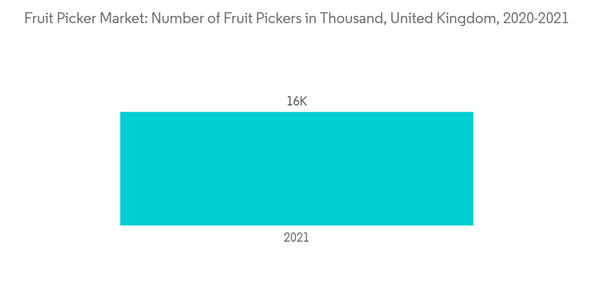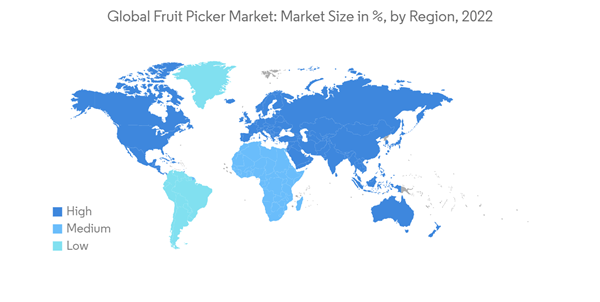Key Highlights
- Fruit rotting on trees or the ground costs farmers USD 30 billion in sales annually, and fruit picked two weeks later loses 80 percent of its value. A major reason for wasted produce, sometimes in fruit rotting on trees, is a global shortage of fruit pickers, estimated to grow to five million missing workers by 2050. Every year, over 800 million tons of fruits are produced on 70 million hectares worldwide, representing an annual market value of USD 1 trillion. Farmers spend annually USD 100 billion on fruit picking and recruit over 10 million temporary workers for a short period to pick their fruit. Even today, more than 10% of all fruit worldwide cannot be harvested, equivalent to the total annual consumption of fruit in the entire European Union.
- Israeli startup Tevel Aerobotics Technologies developed flying autonomous robots that take off from a base station, pick only the ripe fruit off the tree and gently lower it for collection, and can work 24/7 during the harvest period. Kubota invested USD 20 million in Tevel, an industry leader in the flying autonomous fruit-picking robot harvesting segment. Together with Tevel, Kubota will reinforce the company's development of labor-saving and automation technology for fruit picking and enable the launch of a business using these technologies that will contribute to labor-saving and efficiency improvement in farming. Automated fruit pickers are expected to be the market's future, and this technology's workability is expected to show major growth in the coming years.
- According to Tropical Fruit Network, about 1,200 South Pacific fruit pickers have arrived in South Australia to help fill critical shortages of seasonal agriculture workers to encourage unemployed locals to take up fruit picking jobs. The government jointly funded USD 7 million to develop the industry for this. Other factors driving the market are increasing farm mechanization rates, especially in developing countries, increasing farm labor costs, and shorter replacement cycles of tractors attributed to the growth of the global innovative fruit pickers market and expected to grow huge during the forecast period.
Fruit Picker Market Trends
Innovative Fruit Pickers to Improve Efficiency
- Fruit growers are investing in innovative fruit pickers to compensate for the shortage of fruit pickers for fruits, for instance, strawberries, blueberries, avocados, tomatoes, cucumbers, and mandarin oranges. Manual fruit picking will face several challenges with fruit-picking tasks' seasonal and temporary nature. For instance, in the United Kingdom, the number of fruit pickers doubled in 2021, with 16,000 who migrated from 37 countries, including Barbados, Nepal, Tajikistan, and Kenya, due to a lack of workers in the country. Therefore, various adjustable fruit pickers are being introduced to make tasks easier, even for manual tasks. For instance, manual fruit pickers with adjustable working angles and stainless blades are being introduced, saving both the fruit growers' time and energy. By adjusting the angle, the growers can easily cut the fruits at various angles.
- Moreover, robotic fruit pickers are also being introduced, which use algorithms to identify and locate fruits in orchards or nurseries. Thus, to overcome the various challenges of picking fruits, fruit growers invest significantly in products and technologies that can perform multiple activities. This will encourage the producers to develop more innovative products and is expected to grow the market in the coming years.
- In Africa, researchers from Loughborough University innovated six new devices as part of an 18-month project to reduce the impact of recyclable waste in low-middle-income countries to support local African businesses, such as farming, fishing, and construction, by transforming plastic bottles into useful products. Plastic bottles are sourced from communities in Kenya, Rwanda, and Nigeria, from which the 3D avocado harvesting tool has been created from waste plastic water bottles. Depending on the needs of local people and businesses, the reclaimed plastic is turned into a product or tool that would specifically benefit that community.
- For example, in 2022, Singapore-based Singrow developed innovative agronomic solutions for fruit and vegetable production. It used robots in its harvesting and pollination systems using an integrated artificial intelligence (AI) model to help identify the flowers and fruits of strawberries. Singrow checks strawberries with its database using its camera and infrared scanner and programs the robot to select ripe strawberries.
- Robots are game changers for small and medium businesses. Due to the lack of large space in Singapore, small and medium-sized enterprises use robots because they are designed to work close to people and are very easy to operate. These factors will boost the fruit pickers market in the coming years.
North America Leads the Fruit Picker Market
- North America is the largest fruit picker market globally. The United States is one of the largest markets for robotic and manual fruit pickers in the fruit pickers market in North America due to a large number of producers innovating new products to boost the market in the region. In 2021, Advanced Farm Technologies launched TX Robotic Strawberry Harvester in the United States, a California-based company designed to pick on soil-planted strawberry beds so farmers can implement the technology without changing their field design. It automatically senses and picks ripe strawberries with a soft, food-grade robotic gripper and can navigate fields autonomously 24 hours a day.
- These three fruit harvesting technologies and other emerging harvesting tech will likely be game changers for farmers as the population grows and food insecurity persists. It will be vital for farmers to adopt the latest, innovative technologies to improve operational efficiency, yield maximum outputs, overcome labor shortages, and remain profitable.
- Many small players in the North American region are introducing new types of innovative fruit pickers. These are helping the fruit growers across the region manage fruit picking through advancements in manual and robotic fruit-picking tools. For instance, autonomous fruit harvesting equipment maker Advanced Farm Technologies Inc. has designed new robots to pick apples, with the help of a grant from a Washington State AG Group, which is used in California for picking strawberries, and the new equipment will use some of the same software, optics, and robotics the company developed for the new customers in Washington.
- Smart agriculture solutions like this will become increasingly common to meet the rising food demand. The farming industry continues to innovate new products and technology to optimize labor while improving the quality and quantity of food. These factors are driving the market to grow during the forecasting period.
Fruit Picker Industry Overview
The fruit pickers market is highly fragmented, with many small and major players dominating most of the market share. New product launches, partnerships, and acquisitions are the major strategies the leading global companies adopt. Along with innovations and expansions, investments in R&D and developing novel product portfolios will likely be crucial strategies in the coming years. Some of the major players in the market are Agrobot, Dogtooth Technologies Limited, Harvest Croo, FFRobotics, and Flexrake.Additional Benefits:
- The market estimate (ME) sheet in Excel format
- 3 months of analyst support
This product will be delivered within 2 business days.
Table of Contents
Companies Mentioned (Partial List)
A selection of companies mentioned in this report includes, but is not limited to:
- Agrobot
- Dogtooth Technologies Limited
- FFRobotics
- HARVEST CROO
- Flexrake
- Ohuhu
- Corona Tools
- OCTINION
- Peaceful Valley Farm Supply, Inc.
- Red Rooster










